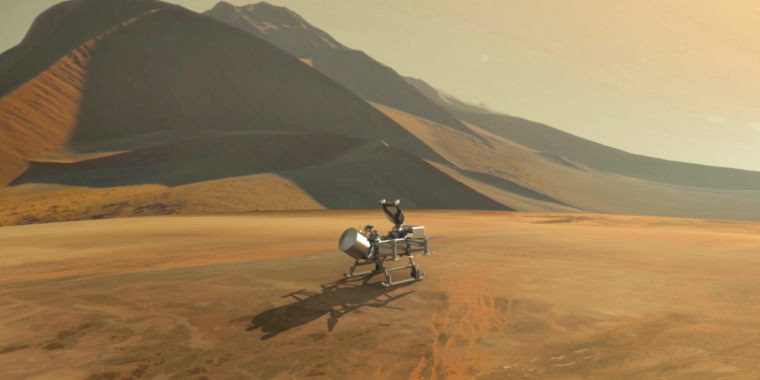
-
Mission concept of Dragon's entry, descent, landing, surface operations, and flight at Titan.
-
Dragonfly on descent to Titan, poised to leave its protective backshell.Johns Hopkins APL
-
Dragonfly on Titan's surface.
-
Dragonfly in flight over Titan.Johns Hopkins APL
-
Dragonfly moving between study sites on Titan.Johns Hopkins APL
-
Dragonfly in flight over Titan.Johns Hopkins APL
On Thursday, NASA announced its next medium-class mission to explore the Solar System—a lander named Dragonfly that will fly like a drone over the surface of Titan, Saturn's largest Moon. Titan has a fascinating environment, with a hydrocarbon atmosphere much thicker than Earth's atmosphere. NASA intends to spend a couple of years exploring its complex chemistry.
NASA scientists were deciding between this Titan explorer and another mission that would have flown to a comet named 67P/Churyumov–Gerasimenko. The comet had been previously visited by Europe's Rosetta spacecraft, which returned a sample of cometary material to Earth.
Of the two missions, the Titan explorer—with an unprecedented design that would fly a vehicle the size of a larger Mars rover over the moon—carried the higher risk. But, half a century after the Apollo lunar landings, NASA decided to go boldly. "A great nation does great things," said NASA administrator Jim Bridenstine.
In 2004, a small spacecraft built by the European Space Agency detached from NASA's Cassini probe in the Saturn system and descended through Titan's thick atmosphere. It only survived about 90 minutes on the surface, but it returned tantalizing information about the complexity of a cold, exotic world that nonetheless has familiar features such as lakes and rivers filled with liquid methane.
"[Dragonfly] has so much potential for fundamental science," said Elizabeth Turtle, a planetary scientist at the Johns Hopkins Applied Physical Laboratory who is the principal investigator for the mission. Scientists believe the complex organic chemistry in the atmosphere of Titan and on its surface may look something like the chemistry on Earth before life developed. "Titan is just a perfect chemical laboratory to understand pre-biotic chemistry," Turtle said.
Cost capped at $1 billion
As a New Frontiers mission in NASA's portfolio, Dragonfly will be cost-capped at $1 billion. It is the fourth mission in this medium classification, following the New Horizons Pluto flyby mission, the Juno spacecraft now at Jupiter, and the OSIRIS-REx mission exploring the Bennu asteroid. It is expected to launch in 2026, aboard an unspecified rocket, before reaching Titan in 2034.
Once there, Dragonfly will land in the equatorial region of the moon, which is covered by large sand dunes. A radioisotope thermoelectric generator will recharge a battery, which in turn will power Dragonfly's rotorcraft flight system for a couple dozen flights across the surface of Titan during a period of 2.5 years. Over that time, Dragonfly will cover about 180km, a sizable chunk of a Moon that is 5,149km in diameter—about 1.5 times the size of Earth's Moon.
While flying on distant moon may sound ambitious, Turtle said it is by far the most expedient way to get around Titan. The moon's atmosphere is about four times thicker than Earth's atmosphere, and the gravity is one-seventh that of our planet. This means Dragonfly's rotors should be able to fly the vehicle around with relative ease.
Before the announcement, scientists were excited about the scientific potential of a Titan mission but worried that NASA might spurn it due to the high risk. However, after the announcement, NASA's chief of science, Thomas Zurbuchen, said the agency worked with Turtle and her team to reduce a number of serious risks and enhance the mission's chance of success.
"We want to do something bold and take measured risks," said Zurbuchen, who added that the weight of Apollo's 50th anniversary has been on his mind. This is an agency that has done great things, and his Science directorate wants to live up to that legacy.
"I've been asking myself what it means to be a part of an agency that has this great history," he said. One thing it appears to mean is that NASA could have something to celebrate on the 65th anniversary of the Apollo 11 Moon landing.
Listing image by Johns Hopkins APL
https://arstechnica.com/science/2019/06/nasa-will-fund-a-revolutionary-mission-to-fly-through-titans-atmosphere/
2019-06-27 22:33:00Z
52780322326342
Tidak ada komentar:
Posting Komentar